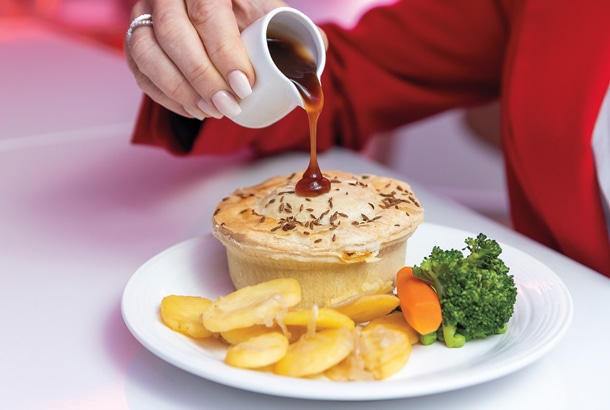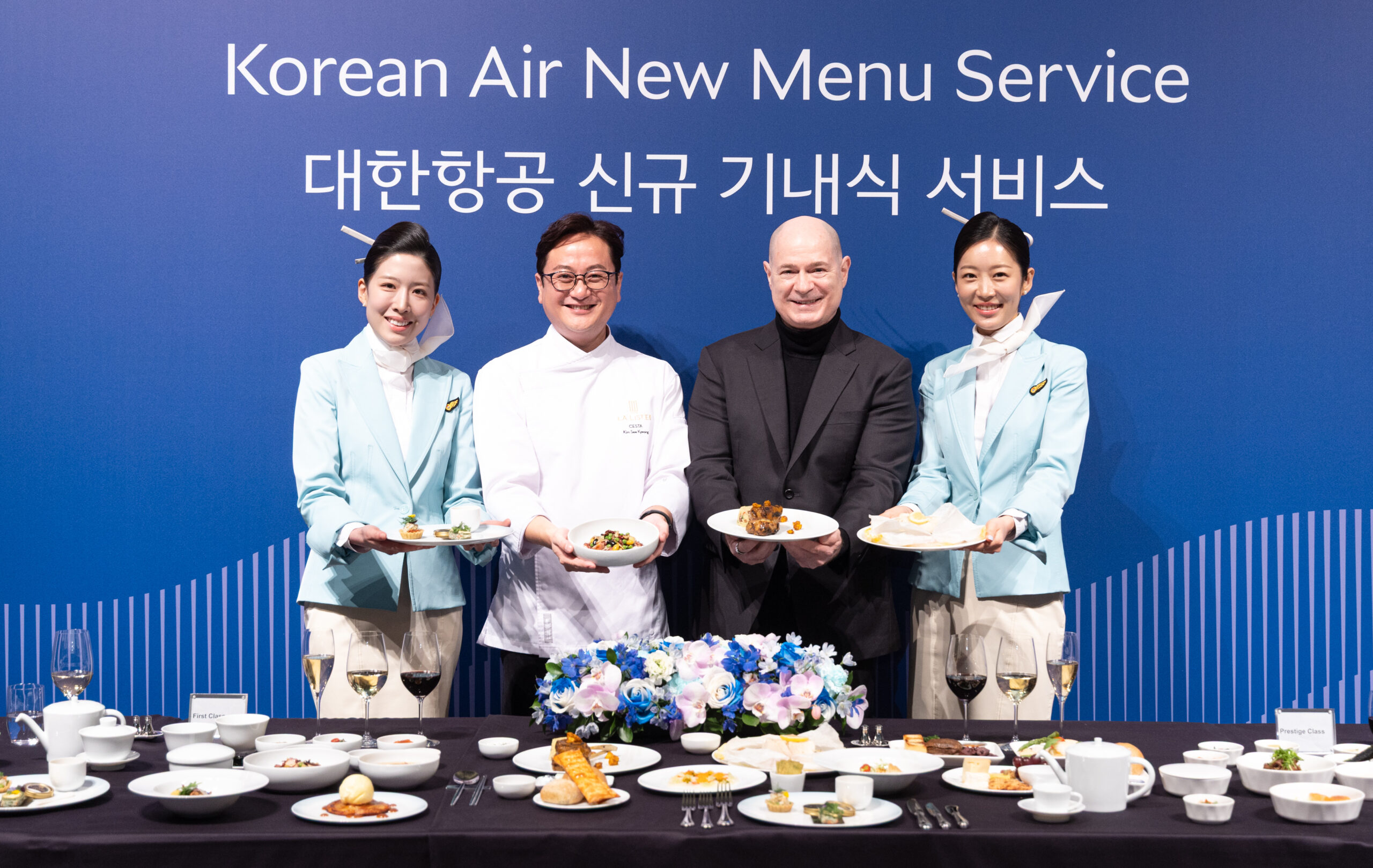Across the Aviation Industry, Meatless Menus Are Taking Off
August 29, 2022

Economy passengers have heard “beef, chicken or pasta” for decades, while business- and first-class passengers might have been offered “slow-roasted short rib, chicken supreme or baked tortellini.” But for how much longer? With plant-based food taking the gastronomic world by storm—dozens of vegetarian and vegan restaurants are earning Michelin stars, including the top three-star accolade—it’s making its way onto aircraft, too.
“Plant-based food is a trend that has been sweeping all areas of the hospitality industry for some years now, and it’s here to stay,” says Audrey Hart, senior manager of in-flight services at Virgin Atlantic. “More and more plant-based alternatives to animal-based protein are readily available on our supermarket shelves, vegan burgers are commonplace in restaurants, and the call for more choice is greater than it has ever been.” This plant-based trend is driven by multiple factors, including health, wellness and sustainability.
“Overall,” she adds, “concepts of vegetarianism, veganism or flexitarianism have become much more mainstream. Many are now choosing to consume vegetarian or plant-based meals three to four times a week, so in aviation it’s about empowering consumers to eat in a way that supports their personal values and lifestyle choices.”
While Virgin Atlantic has for many years offered a vegetarian option during meal services, the airline is now focusing on fully plant-based meals and developing them from scratch. “Many plant-based meals used to be dishes where the meat had just been removed or replaced with mycoprotein,” says chef Hari Ghotra, who is the in-flight services manager for the airline. “Today, it’s about thinking harder about the ingredients we’re using, and in many cases going back to old grains and basic ingredients to provide the nutrients and proteins needed in a plant-based diet. There are so many natural alternatives, from lentils and chickpeas to seeds and ancient grains. We are also seeing exciting ingredients such as jackfruit and banana blossom, which provide a great meaty plant-based alternative. And we’re using ingredients in different ways—beetroot hummus, miso dressings, lentil flatbreads, non-cheese sauces made with cashew—to create vibrant, fresh dishes.”

Joseph Markey of LSG Sky Chefs preparing a dish / Photo: Christof Jakob
There has been substantial innovation in food technology in recent years, from the Beyond Meat range of proteins to vegan cheese, as well as the revitalization of traditional production techniques such as fermentation, which can transform vegetables into meat replacements. All Nippon Airways’ Anna Mukai says that the airline is seeing the plant-based trend arriving firmly in the Asian market, and is making the most of Japanese plant-based protein sources and other ingredients to get ahead of the curve.
“Our healthy rice bowl with a plant-based cutlet made of Japanese traditional okara and konjac is a very innovative and exciting dish,” she says. “It imitates the Japanese pork cutlet tonkatsu, which is popular outside Japan, as well. It is satisfying for all passengers.” Konjac is perhaps most familiar in the form of Miracle Noodles (shirataki), which are both low-carbohydrate and low-calorie.
As the number of ultra-long-haul flights of more than 12 hours has burgeoned in recent years, airlines have sought to provide dishes geared to passengers’ well-being, and here plant-based dishes excel. “From an initial start with vegetarian meals available for ordering preflight to the introduction of our first wellness menus in 2016 that included meat-free options, Singapore Airlines has a long history of developing and offering plant-based meals,” says the carrier’s director of food and beverage, Antony McNeil.
In the New York metro area, where the airline serves both JFK and Newark, Singapore is working with aeroponic farming producer AeroFarms on a farm-to-tray-table local sourcing initiative. AeroFarms’ greens are grown five miles from Newark Airport, and are served to passengers approximately 24 hours after harvest. This indoor, pesticide-free production brings a variety of benefits to the airline.
“In addition to the reliability of a product grown under highly consistent conditions—stable temperature, light exposure and humidity controls that allow us to go from seed to harvest in about 12 days—we can offer greens that are incredibly fresh, with no need for washing to remove pesticides,” McNeil says. This provides “a firmer, more robust product. In addition, greens are grown without sunlight under a special recipe of UV spectrum, developed to more fully express each plant’s nutritional and flavor characteristics—such as peppery notes in arugula or a wasabi-like tang in microgreens—than would be possible in a traditional outdoor farm environment.”

Purple gnocchi with blue cheese from LSG Sky Chefs / Photo: Christof Jakob
Singapore Airlines is also working with chefs like Greg Frey, Jr., of California’s Golden Door resort to ensure that plant-based dishes are just as colorful, flavorful and exciting as the rest of its menu. The first set of meals from this partnership included a portobello-mushroom “meatball” dish on plant-based risotto with a spicy marinara sauce. A key part of getting plant-based meals onto air-craft is the global network of catering companies that design, produce and supply meals to airlines, such as LSG Sky Chefs, which recently partnered with milk- and meat-replacement producer NotCo. I sat down with LSG executives for lunch recently, with highlights including a vegan “egg yolk” made of spherified carrot that could easily have been served in a top-notch restaurant in one of the world’s great gastronomic centers.
We touched on a number of topics, including how food—particularly plant-based food—can communicate a premium or luxury feel, especially compared to conventional luxury foods like caviar, lobster and filet mignon. “The understanding of ‘luxury’ or ‘premium’ is related to your cultural environment,” says LSG’s Dominik Sharaf. “Exclusive ingredients are part of this, but more common products that are prepared with artisanal excellence can also be ‘premium,’ as well as progressive innovations and food technology. If you offer plant-based products that are very rare and difficult to purchase, that might be considered ‘luxurious.’ In high-level gastronomy, a current trend is putting vegetables in the focus. Instead of meat alternatives, celeriac, black salsify or fried lettuce might be the main component of a main course.”
The growth in meal-replacement drinks such as Soylent and Huel, too, is likely to trend into aircraft, whether as preprepared or single-serving mix packets. Across the plant-based spectrum, says Sharaf, “the interest is huge. Also, food trends tend to be long-lasting. This means that plant-based alternatives will be relevant in the near future and beyond.”




